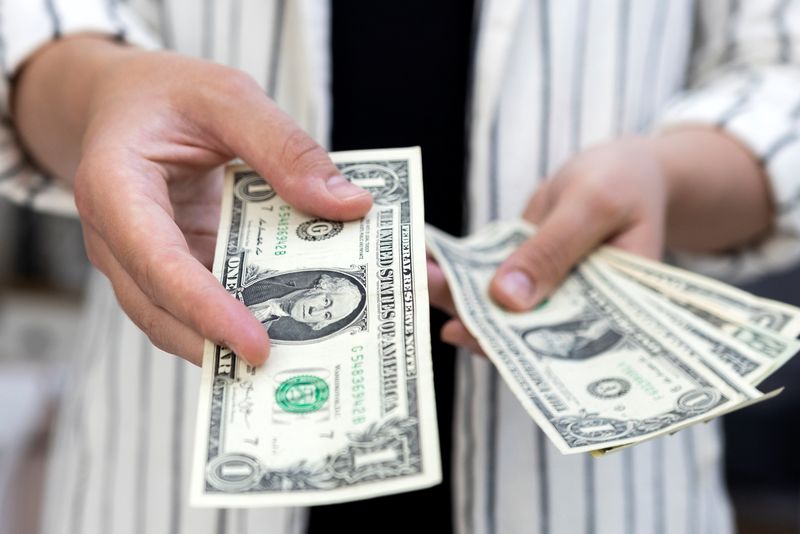Forex
US dollar bounces as strong jobs report likely delays Fed easing this year

By Gertrude Chavez-Dreyfuss
NEW YORK (Reuters) -The U.S. dollar rebounded on Friday after data showed the world’s largest economy created a lot more jobs than expected last month, suggesting that the Federal Reserve could take time in starting its easing cycle this year.
The , which tracks the currency’s value against six major peers led by the euro, rose 0.8% to 104.91, its best daily gain since April 10.
For the week, the index was on track for a 0.2% gain, with the strong jobs number offsetting a run of weaker macro data that had earlier prompted investors to put two quarter-point Fed rate cuts back on the table in 2024.
U.S. nonfarm payrolls expanded by 272,000 jobs last month, data showed, while revisions showed 15,000 fewer jobs created in March and April combined than previously reported. Economists polled by Reuters had forecast payrolls advancing by 185,000.
Average hourly earnings rose 0.4% after having slowed to a 0.2% rate in April. Wages increased 4.1% in the 12 months through May following an upwardly revised 4.0% annual rise the prior month.
The unemployment rate, however, edged up to 4% from 3.9% in April, breaching a level that had previously held for 27 straight months.
“The markets and the Fed bow down to the holy grail of one number, and it is the payrolls report. Of course, it is not just about that headline print but also the higher-than-expected wage number,” said David Rosenberg, founder and president of Rosenberg Research in Montreal.
“But as they say — ‘it is what it is.’ And because we know what the Fed is laser-focused on, and how the Fed is so omnipresent when it comes to market activity in stocks and bonds, consider this to be a bearish report because it simply will embolden the hawks on the FOMC (Federal Open Market Committee).”
The FOMC is not expected to make any change at its policy meeting next week,
Following the jobs data, the rate futures market has priced in just one cut of 25 basis points this year, either at the November or December meeting, according to LSEG’s rate probability app.
The chances of a rate cut in September declined to about 50.8% post-jobs, from around 70% late on Thursday.
The dollar rose 0.6% against the yen to 156.64. The U.S. currency was still down 0.4% on the week, on track for its worst weekly performance since late April, or around the time Japanese monetary authorities stepped in to the market to prop up the yen.
Like the Fed, the Bank of Japan decides rate policy next week, and consensus is building in the market for an imminent reduction in its monthly bond purchases as a means of tightening credit conditions.
Despite recent firmness, the yen remains not far from the 34-year trough beyond 160 per dollar reached at the end of April, which prompted Japanese officials to spend some 9.8 trillion yen ($62.9 billion) intervening in the currency market to support it.
The euro, meanwhile, dropped 0.8% versus the dollar to $1.0803. On the week, Europe’s single currency slid 0.4%, its largest weekly percentage loss since the week starting April 8.
The currency’s losses also came a day after the European Central Bank cut rates in a well-telegraphed move, but offered few hints about the outlook for monetary policy given that inflation is still above target. Sterling, meanwhile, retreated 0.5% against the dollar to $1.2722 after earlier in the session hitting $1.2825, the highest level since mid-March.
Currency
bid
prices
at 7
June
07:19
p.m. GMT
Descript RIC Last U.S. Pct YTD High Low
ion Close Chang Pct Bid Bid
Previous e
Session
Dollar 104.88 104.11 0.76% 3.46% 104.93 103
index .99
Euro/Dol 1.0803 1.089 -0.8% -2.13% $1.090 $1.
lar 3 080
1
Dollar/Y 156.63 155.95 0.44% 11.05% 157.05 155
en .14
Euro/Yen 1.0803 169.44 -0.15 8.71% 169.97 168
% .95
Dollar/S 0.8964 0.8893 0.8% 6.52% 0.8972 0.8
wiss 881
Sterling 1.2719 1.2791 -0.54 -0.03% $1.282 $1.
/Dollar % 5 080
1
Dollar/C 1.3749 1.367 0.59% 3.73% 1.3758 1.3
anadian 663
Aussie/D 0.6582 0.6667 -1.25 -3.44% $0.668 $0.
ollar % 1 658
1
Euro/Swi 0.9682 0.9683 -0.01 4.26% 0.9708 0.9
ss % 678
Euro/Ste 0.849 0.8512 -0.26 -2.05% 0.852 0.8
rling % 49
NZ 0.6107 0.6201 -1.46 -3.31% $0.620 0.6
Dollar/D % 3 106
ollar
Dollar/N 10.7092 10.5439 1.57% 5.66% 10.716 10.
orway 1 529
2
Euro/Nor 11.5681 11.4855 0.72% 3.08% 11.575 11.
way 2 471
4
Dollar/S 10.541 10.3911 1.44% 4.71% 10.548 10.
weden 350
7
Euro/Swe 11.3863 11.3143 0.64% 2.35% 11.398 11.

den 1 274
8

 Forex3 years ago
Forex3 years agoForex Today: the dollar is gaining strength amid gloomy sentiment at the start of the Fed’s week

 Forex3 years ago
Forex3 years agoUnbiased review of Pocket Option broker

 Forex3 years ago
Forex3 years agoDollar to pound sterling exchange rate today: Pound plummeted to its lowest since 1985

 Forex3 years ago
Forex3 years agoHow is the Australian dollar doing today?

 Cryptocurrency3 years ago
Cryptocurrency3 years agoWhat happened in the crypto market – current events today

 World3 years ago
World3 years agoWhy are modern video games an art form?

 Commodities3 years ago
Commodities3 years agoCopper continues to fall in price on expectations of lower demand in China

 Economy3 years ago
Economy3 years agoCrude oil tankers double in price due to EU anti-Russian sanctions























